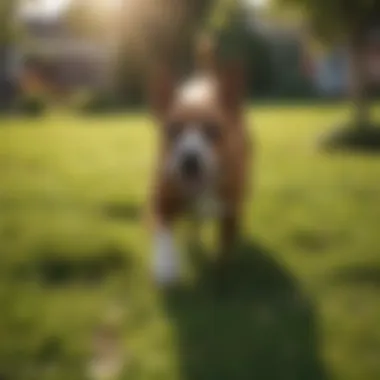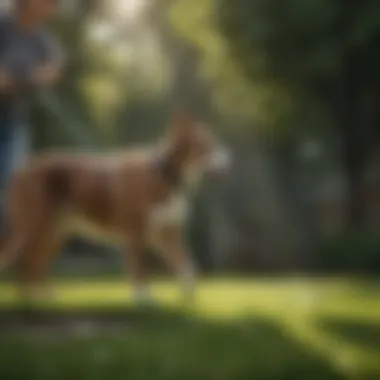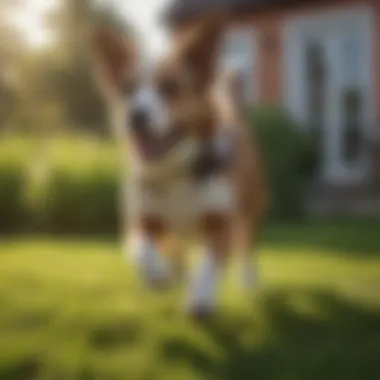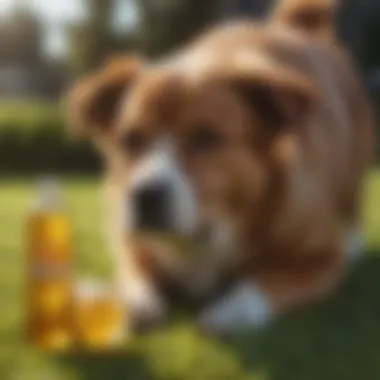Effective Strategies to Safeguard Grass from Dog Urine


Intro
Dog owners often find themselves in a bit of a pickle when it comes to preserving their lawns while ensuring the happiness of their furry companions. Dog urine can wreak havoc on grass, leaving unsightly brown patches that not only disturb the aesthetic appeal of a yard but also raise questions about lawn health. This often overlooked issue can lead to frustration and disappointment for many pet owners.
In essence, understanding how to effectively safeguard grass from urine damage is not just a matter of aesthetic concern; it reflects on broader themes of pet care and environmental mindfulness. Thus, this article aims to illuminate various strategies for mitigating the impact of dog urine on lawns, providing practical measures that blend both common sense and scientific understanding.
Economically speaking, a lush, green lawn often signifies not just a visually pleasing home, but also an investment in property. Homebuyers frequently look for well-maintained yards, which can even influence home prices. Therefore, addressing the issue of urine damage isn’t merely about maintaining a beautiful garden; it’s about protecting one’s investment in their property and keeping the community visually pleasant.
Through this exploration of effective strategies, keep in mind that a balance must be struck between the needs of our pets and the health of our outdoor spaces. Reading on, you'll discover a mix of time-tested methods, innovative solutions, and extensive knowledge to help you adapt your lawn care practices.
This journey into enhancing turf health while accommodating dog ownership begins with an understanding of what exactly happens when our dogs do their business on our beloved lawns.
Understanding the Impact of Dog Urine on Grass Health
A healthy lawn is often considered a prized possession for many dog owners. However, things can get tricky when your four-legged friend decides to use your grass as a personal restroom. Understanding the impact of dog urine on grass health is crucial for maintaining lawn aesthetics and vitality. Dog urine contains high levels of nitrogen, along with salts and other components, which can create a toxic environment for grass if not addressed correctly. Knowing this can save your green oasis from turning into a patchy disaster.
Unraveling the chemistry behind dog urine is not just a scientific endeavor; it brings practical benefit. Such knowledge allows pet owners to adopt effective strategies aligned with their dog's needs while still preserving the grass. Furthermore, recognizing the symptoms of grass damage provides an early warning system, enabling prompt intervention. This proactive approach not only saves time but also minimizes costs associated with lawn repair.
The Chemistry of Dog Urine
Dog urine is more than just liquid waste; it contains urea, creatinine, uric acid, and various other substances. Urea, which makes up a significant portion of it, contributes to nitrogen in the soil. While nitrogen is essential for plant growth, too much of it can burn the grass, especially if the urine is concentrated in one area. The salts present in dog urine can further exacerbate the issue, leading to dehydration and nutrient imbalance within the grass.
These elements collectively create a high-risk scenario for your lawn, especially if your dog is a frequent urinator in specific spots. The concentration of these chemicals often leads to a "burn" effect, presenting as dark, dead patches peppered across an otherwise vibrant green setting.
Common Symptoms of Grass Damage
Identifying symptoms of dog urine damage is an important skill for maintaining a healthy lawn. Classic signs include:
- Yellowing of Grass: Often seen as patches that turn from green to yellow, signaling nitrogen overdose.
- Browning at Tips: The tips of the grass blades may begin to brown, particularly if the dog frequently uses the same areas.
- Spotty Growth: Areas affected by urine may exhibit stunted growth, often resulting in clumps of vibrant grass interspersed with patches that struggle to survive.
- Uneven Texture: Healthy grass can feel lush and soft, while damaged spots may feel rough and brittle.
Recognizing these symptoms promptly allows for timely damage mitigation tactics. Relying on observation can make a real difference in lawn recovery efforts.
Identifying Grass Types Susceptible to Damage
Not all grass varieties respond the same way to the onslaught of dog urine. While some grass types boast resilience, others may fall victim to damage quite easily. Common types susceptible to dog urine damage include:
- Kentucky Bluegrass: While beloved for its rich color, it is sensitive to nitrogen overload from urine, leading to noticeable damage.
- Bermudagrass: A favorite in warmer climates, this grass can also suffer when exposed to concentrated urine.
- Fescue: This variety may show signs of damage, especially if not well-established.
Conversely, some turf grasses, like Zoysiagrass, show more resilience and may not deteriorate as rapidly under similar conditions. Understanding the specific characteristics of the grass you have can aid in devising effective action plans for preservation. The interplay between beloved pets and flourishing lawns is a balancing act—recognizing your grass type is the first step in maintaining that delicate equilibrium.
Preventative Measures for Lawn Care
When it comes to maintaining a healthy lawn in the presence of dogs, planning ahead is crucial. Preventative measures serve as the first line of defense against grass damage caused by dog urine. By choosing the right strategies, you can create an environment that nurtures both your lawn and your pets. Taking these steps is beneficial in many ways, from preserving the aesthetic appeal of your garden to enhancing the overall soil health, making it a top priority for pet owners and gardening enthusiasts alike.
Designing a Dog-Friendly Lawn
Choosing Durable Grass Varieties
Selecting the right type of grass is akin to laying a solid foundation for a house. Some grass varieties are inherently more forgiving when it comes to dog urine. For instance, fescue grasses, such as tall fescue, are known for their resilience and ability to recover quickly. They can often bounce back even after being subjected to the harsh effects of pet urine. With their robust root systems, these grasses not only withstand foot traffic but also help absorb excess nitrogen from the urine, partially mitigating its harmful effects.
Yet, it’s not just about resilience; it’s essential to consider the grass's suitability to your region's climate. Zoysia grass, for instance, thrives in warmer areas and has a good drought tolerance. However, the time it takes to establish can be longer compared to other varieties. The choice of grass should align with both the climate and the specific needs of your dog.
Establishing Designated Urine Areas
Another effective strategy is setting up specific zones for your dog to relieve itself. Establishing designated urine areas can significantly reduce the spread of lawn damage. By training your dog to use a particular spot, you localize the impact of urine, allowing other areas of the lawn to flourish without being subjected to concentrated nitrogen levels. You can enhance these zones with materials like gravel or mulch, which not only absorb moisture but also help control odors.


The key characteristic of this method is its ability to prevent widespread lawn damage—allowing a clear boundary between your dog's activities and the rest of your garden. This practice might require some effort initially, but the pay-off is worth it. Ultimately, it reduces stress on your grass and ensures a more balanced garden.
Enhancing Soil Health
Utilizing Organic Amendments
Taking care of your lawn's soil is like providing the right fuel for a car; it’s essential for the enduring health of the grass. Incorporating organic amendments, like compost or well-aged manure, nourishes the soil and encourages beneficial microbial activity. Such amendments enhance soil structure, improving water retention and aeration, which are vital for grass recovery.
The benefit of using organic amendments lies in their gradual nutrient release, which helps plants absorb what's needed without causing nutrient overload. However, keep in mind that not all organic matter is created equal; some materials may take longer to break down compared to others, requiring careful planning in timing and application.
Maintaining Proper pH Levels
Achieving and maintaining the right pH level is essential for optimal nutrient uptake in grass. Most grass types flourish in slightly acidic to neutral pH levels (around 6.0 to 7.0). When the pH is off-kilter, nutrient absorption can be hindered, making the grass more susceptible to damage, including that from dog urine.
You can test your soil with a simple kit from a gardening store. If the pH is outside the desired range, remedies like lime or sulfur can be added to adjust it. One advantage of this practice is its long-term impact—it not only helps your grass stand tall against the effects of dog urine but also promotes an overall healthier lawn.
Implementing Irrigation Techniques
Watering Immediately After Urination
Pouncing on the opportunity to water your grass immediately after your dog has urinated is an effective countermeasure. It dilutes the urine and helps to wash away excess nitrogen, minimizing grass burn. This practice is straightforward and doesn’t require special equipment. A simple watering can or hose can do the trick.
The practice's efficiency lies in its timing; prompt action can make a noticeable difference in grass recovery. Nonetheless, one potential downside is that it might create additional work for pet owners, especially if the dog is frequently in the yard.
Installing Drip Irrigation Systems
Investing in a drip irrigation system can further ensure that your lawn receives adequate hydration. This method delivers water directly to the root zone, making it efficient in preventing dry patches while helping to dilute any urine damages.
One of the advantages of drip systems is their water-saving potential, especially in dryer periods. However, installation can be complex and may require initial investment and setup time. But once established, these systems can provide a consistent watering regimen, reinforcing the lawn's health and resilience to foot traffic and urine exposure.
Key Takeaway: Implementing thoughtful strategies for lawn care not only protects your grass but also enriches the relationship between yourself and your pets, creating a harmonious living environment.
Remediation Techniques for Affected Grass Areas
Addressing the damage caused by dog urine on grass is critical for maintaining a lush, healthy lawn. Remediation techniques involve a variety of methods that focus on assessing the extent of damage and implementing recovery strategies. These techniques not only help restore the grass but also promote a sustainable environment for both pets and plants. Understanding these strategies can equip pet owners with the right tools to salvage their lawns.
Assessing Damage Severity
Before diving into recovery methods, it’s important to understand how severe the damage is. Damage assessment can determine the appropriate actions to take.
Visual Inspection Techniques
Visual inspection is the first step in evaluating the damage. This involves looking for discolored patches of grass and assessing their size. A clear indicator is often the yellowing or browning of patches, which are telltale signs of urine burns.
- Key Characteristic: This method allows for quick identification of affected areas without needing specialized equipment.
- Benefit: It’s cost-effective; anyone can do it with just their eyes and a keen sense for detail.
- Unique Feature: It’s immediate and doesn’t rely on fancy instruments, making it accessible for everyone.
However, while this method provides initial insight, it may lack depth. Factors like soil health can be missed, leading to incomplete assessments.
Conducting Soil Tests
Conducting soil tests adds a layer of depth to the damage assessment process. It involves analyzing the soil's nutrient levels and pH balance, which can further clarify the grass's health.
- Key Characteristic: Soil tests provide a snapshot of the underground conditions that affect grass health.
- Benefit: This method helps pinpoint specific deficiencies that may not be visible on the surface, leading to targeted interventions.
- Unique Feature: The comprehensive data gained can inform fertilization and amendment strategies.
Nonetheless, soil testing can be slower and might involve costs for sending samples to a lab. It may not be as immediate as visual checks, but it delivers precision.
Mitigating Damage with Recovery Practices


Once the extent of the damage is clear, the focus shifts to recovery strategies that can bring the grass back to health.
Lawn Aeration Methods
Aeration is an effective technique to alleviate soil compaction and improve water absorption. This process involves perforating the soil with holes to allow air, water, and nutrients to penetrate down to the root level.
- Key Characteristic: It enhances the overall breathing process within the soil.
- Benefit: Aeration can stimulate vigorous grass growth, enabling quicker recovery from urine damage.
- Unique Feature: The method can help tackle other underlying issues that might not be immediately visible, providing a holistic approach.
However, aeration can require equipment or assistance, which may not appeal to every pet owner.
Overseeding Strategies
Overseeding involves applying grass seed directly to existing turf, which can be particularly effective for revitalizing the affected zones. It helps fill in bare patches and improves lawn density.
- Key Characteristic: This method bolsters the lawn’s resilience to future urine exposure.
- Benefit: Overseeding can enhance the appearance of the lawn and promote a fuller, greener turf.
- Unique Feature: The process can be done in combination with aeration, leading to greater long-term benefits.
It’s worth noting though, that overseeding requires proper timing, typically in the cooler months, when the existing grass can support the new seed.
Utilizing Products for Grass Recovery
In addition to natural methods, certain products can enhance recovery and promote grass health.
Organic Lawn Fertilizers
Using organic lawn fertilizers can help replenish lost nutrients due to dog urine damage. They often contain a blend of natural materials that benefit soil health over time.
- Key Characteristic: Organic fertilizers are gentle on the environment and pets, promoting a sustainable approach.
- Benefit: They encourage microbial activity and buildup beneficial for grass recovery.
- Unique Feature: Their slow-release nature can lead to longer-lasting effects when compared to synthetic options.
On the downside, these products may be slower to show visible results than chemical fertilizers, requiring patience.
Specialized Soil Conditioners
Specialized soil conditioners, such as compost or peat, can improve soil structure and moisture retention, critical for grass recovery.
- Key Characteristic: They improve the soil's ability to hold water and nutrients, right where they’re needed.
- Benefit: They can create a supportive environment for grass to thrive post-damage.
- Unique Feature: Some conditioners are designed to specifically tackle saline build-up from dog urine, which is often overlooked.
However, these products can sometimes be more expensive than regular soil amendments, making cost a consideration for homeowners.
It's crucial to consider which strategies best suit the unique situation of each lawn, as each method has its advantages and potential drawbacks.
In sum, understanding and implementing these remediation techniques can help restore the beauty of lawns affected by dog urine damage. With the right mix of observational and intervention strategies, grass health can be reclaimed, fostering a harmonious balance between pet ownership and lawn care.
Creating a Balanced Environment for Pets and Lawns
Creating a harmonious relationship between pets and lawns is essential. It’s not just about having a green space; it's about establishing a home where both your dog and your grass can thrive. Dogs are naturally curious creatures, and their habits can inadvertently lead to lawn damage, particularly due to the nitrogen and salts found in their urine. However, with the right strategies, you can set up an environment that minimizes the negative impacts on your grass while allowing your furry friend to enjoy their outdoor space.
This section explores several practical approaches, focusing on training routines for your pets and incorporating lawn-friendly practices. Such efforts help maintain the health of your grass even in the midst of dog ownership, ensuring that both lawns and dogs can coexist with relative peace.
Establishing Training Routines
Having a plan for how your dog interacts with your lawn is crucial. Training routines can guide them to areas designated for their bathroom needs. This not only helps protect your grass but also encourages discipline in your pets, simplifying the whole process of outdoor time.
Redirecting Public Urination
Redirecting public urination is all about helping your dog understand where it is appropriate to relieve themselves. This technique focuses on teaching them to use specific spots rather than the whole yard. It’s a straightforward concept but very effective. By doing this, you can drastically reduce the damage that often occurs when dogs wander freely across a lawn. It’s beneficial because it sets clear boundaries for your dog. Plus, once they grasp the concept, it becomes a routine. However, patience is key, as it may take time for some dogs to grasp the new routine.


"Training a dog takes time, but the rewards can be long-lasting, both for your lawn and your pet's happiness."
Using Positive Reinforcement
Positive reinforcement is a well-regarded training method that involves rewarding your dog for desired behaviors. When they successfully use the designated areas for urination, offer them praise or a treat. This approach works beautifully in establishing good habits, and not just for bathroom behavior. The key characteristic is its focus on encouraging the dog instead of punishment for mistakes. The benefits are significant; dogs respond well to positive reinforcement, making it a popular choice among pet owners. One potential downside is that it requires consistency; forgetting to provide rewards can confuse the dog and undermine the training efforts.
Introducing Lawn-Friendly Dog Practices
Integrating dog practices that respect your lawn's needs is the next logical step. These practices should not only benefit your grass but also suit your dog's needs. Implementing lawn-friendly habits can create a win-win situation.
Regularly Scheduled Walks
Establishing regularly scheduled walks is an effective practice. Taking your dog out consistently encourages them to relieve themselves during walks instead of in the yard. This method keeps your lawn safe and strengthens the bond between you and your pet. While it ensures more bathroom breaks outdoors, it also gives your dog regular exercise. An obvious drawback might be the necessity of timing, as it can restrict spontaneity in your schedule.
Designating Specific Play Areas
Designating specific play areas in your yard can help protect sensitive grass sections. By allowing your dog to have fun in specific locations, you minimize the damage often caused by their natural instincts. This practice is beneficial because it helps maintain the grass’s health while allowing dogs to release their energy. However, it may require modifications to your yard. Individualizing space for your dog can be somewhat limiting depending on your yard size, but the benefits of targeted areas often outweigh the negatives.
Monitoring Grass Health Over Time
Keeping an eye on your lawn's health over time is essential in achieving lasting balance. This involves regular assessments of your grass and adjusting care as needed. A proactive approach will help catch potential issues before they escalate.
Setting a Lawn Care Schedule
Creating a lawn care schedule can significantly enhance the health of your grass. Regular inspections, watering, and maintenance tasks help find and correct problems early. The routine functions like clockwork, ensuring areas are not overlooked. However, diligent record-keeping and follow-through are necessary to maximize effectiveness.
Adjusting Maintenance Techniques as Needed
As seasons change or your dog continues to grow, adjusting your maintenance techniques becomes a necessity. This aspect of care allows you to adapt to new challenges. You might find certain grass types require more water in summer while others need less nutrition in fall. The advantage here is flexibility: you can modify approaches to suit real-time needs. A potential downside might be measuring success, as it can take time to see results and establish what techniques work best.
Future Considerations for Lawn and Pet Management
When thinking about the shared spaces between lawns and pets, effectively managing dog urine is a multifaceted challenge that requires foresight and planning. Understanding the complexities of what occurs when canine biology meets grass ecology is crucial. Beyond just solving immediate problems, the emphasis on future strategies can aid in the sustainable coexistence of pets and healthy lawns. Proactive measures can help mitigate damage while fostering an environment that supports both desired aesthetics and the natural behaviors of our dogs.
Researching Innovative Solutions
The focus on innovative solutions is increasingly becoming a necessity. With scientific strides, there are numerous products and methods that can alleviate some of the trouble caused by dog urine. For instance, researchers are currently studying the genetic engineering of grass species. Some varieties might be able to tolerate higher nitrogen levels that are often found in dog urine. This could create lawns that are less prone to burn and degradation when faced with regular dog use.
To break it down further, modern technology allows us to explore alternative approaches:
- Bioengineering: Grass with enhanced resilience to urine components may offer promising results in the future.
- Custom Fertilizers: New recipe formulations could be tailored to counteract the effects of dog urine on specific grass types.
- Odor Solutions: Products that neutralize odors help mask the spots while facilitating recovery could lead to happier pets and owners.
The Role of Community Awareness
Community involvement can significantly sway the success of any initiative surrounding lawn management during pet ownership. Engaging pet owners through education can help promote more responsible behaviors while also acknowledging their need for convenience.
Building a supportive community provides multiple avenues for discussion and sharing solutions:
- Awareness campaigns could spotlight the importance of solutions like designated potty areas. This makes it clear to all pet owners that they can contribute to a healthier neighborhood.
- Workshops on lawn care that involve pets can entice participation. This might include practical demonstrations on treating grass post-urinization or establishing appropriate training guidelines for dogs.
- Online forums and social media platforms create spaces to share anecdotes, successes, and tactics. This peer-supported dynamic can foster a spirit of cooperation and innovation.
Advocating for Sustainable Practices
As more individuals acknowledge the intertwining relationship between maintaining lawns and pet care, advocating sustainable practices becomes essential. Not only is it about the immediate results on grass health, but it also encompasses the larger picture of environmental stewardship.
Practices worth considering include:
- Natural Lawn Treatments: Shifting away from synthetic fertilizers and pesticides towards organic options. These are safer for pets and contribute positively to soil and grass health.
- Composting: Recycling pet waste appropriately can create a sustainable cycle. When done properly, this can even enrich the soil, benefiting overall lawn health.
- Rainwater Harvesting: Keeping lawns well-hydrated in a natural way reduces reliance on municipal water supplies while offering sustained irrigation directly to the roots of your grass.
Continuing to advocate for these strategies adds layers of benefit that transcend individual lawns, impacting local ecosystems positively.
"Ensuring a balance between our love for pets and the health of our lawns is a commitment, but one that yields significant rewards in both beauty and sustainability."
In summary, focusing on future considerations is not merely about addressing dog urine damage but involves cultivating a responsible culture around gardening and pet ownership. By researching, by enhancing community awareness, and by advocating for sustainable practices, we can turn lawns into spaces that are both lively with the energy of playful dogs and lushly green, thriving landscapes.



